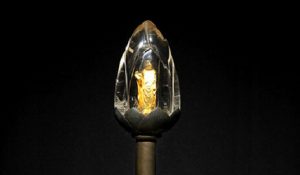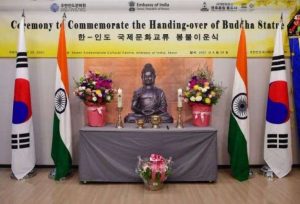
Arguably the most important symbol in Buddhism, the lotus not only represents spiritual purity, but also serves as a reminder that all beings are capable of attaining enlightenment. According to the Buddhist teachings, just as the lotus rises up from the depths of muddy ponds and lakes to blossom immaculately above the water’s surface, so too can the human heart or mind develop the virtues of the Buddha and transcend desire and attachment to reveal its essentially pure nature. For this reason, this flower appears in every aspect of Buddhist art in all Buddhist cultures, from the real lotus flowers in temple gardens to the lotus thrones that support Buddhist deities in sculpture and painting. The lotus is also prevalent throughout Buddhist Asia as a decorative motif in textiles, ceramics, metalwork, bronzes, and lacquerware.
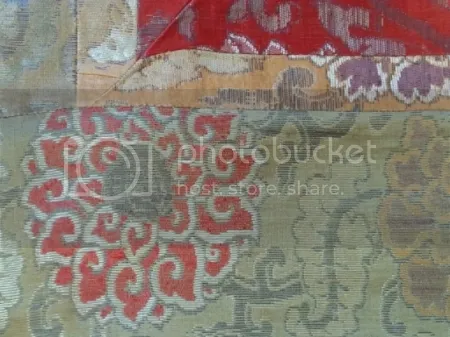
century, brocade. Image courtesy of the author
One of the most important representations of the lotus in Buddhist art is the lotus throne. In painting and sculpture from most parts of Buddhist Asia, figures of Buddhas and bodhisattvas and other major deities are typically depicted either seated or standing on a lotus in full bloom. Because these deities are considered enlightened beings, the lotus throne symbolizes their divine manifestation and perfected spiritual state. In a variation of this representation in Tibetan Buddhist imagery, the compassionate female deity Green Tara is often represented seated on a lotus with her right leg extended, symbolizing her readiness to leap into action to help beings: the foot is typically depicted resting on a separate lotus. In both painting and sculptures, the petals of the lotus are often arranged in layers to suggest the unfolding of the flower as it opens, with each petal given linear texturing to create volume and gilding to enhance its delicate beauty.
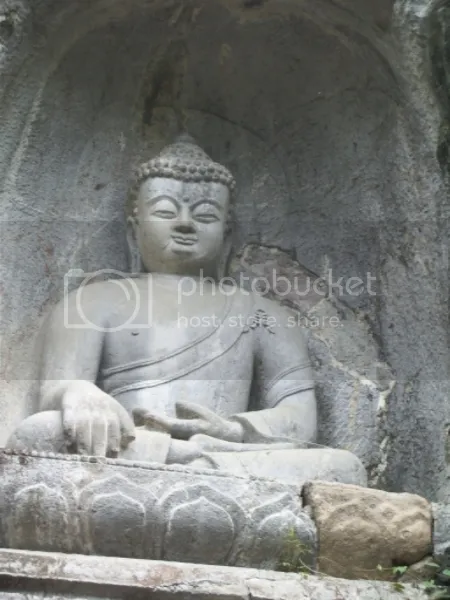
10th century, stone. Photo by the author
In the Mahayana vehicle of Buddhism in East Asia, with its rich imagery and complex iconography, the lotus plays diverse roles. One of the most widely practiced deities here is Avalokiteshvara, who is depicted in many different forms, all of which hold a single lotus in one hand. This deity, known in Tibetan as Chenrezig, in Chinese as Guanyin, and in Japanese as Kannon, is the epitome of the compassion of the bodhisattvas—beings who have postponed their own enlightenment in order to remain in this world to benefit others. In images of this deity, the lotus flower represents the advanced spiritual state and commitment to help beings realize their potential for perfection. Avalokiteshvara is also the principal deity in the Lotus Sutra, one of the most widely followed Buddhist texts in East Asia. His consort is Tara, who holds the stem of a lotus in one or both hands.
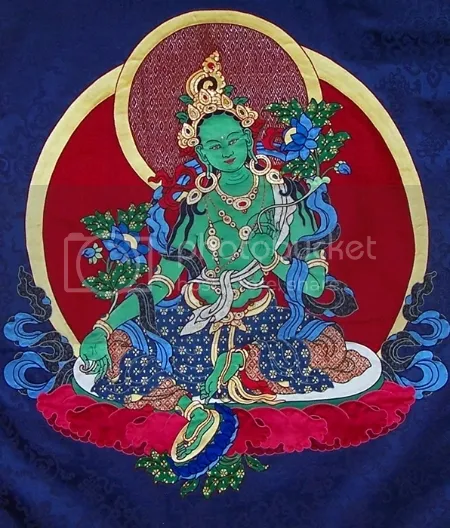
and pearl, 2008. Image courtesy of the artist
In Mahayana Buddhism, lotuses are also associated with the Buddha Amitabha or Amitayus, one of the five transcendent Buddhas, who is believed to reside in the Pure Land of Sukhavati, the “Land of Bliss,” a Buddhist paradise in the West. In the Pure Land school of Mahayana, devotees aspire to be reborn in this Western Pure Land by relying on Amitabha in the present life, and are believed to be reborn in lotuses growing in a celestial pond. The more virtuous devotees are said to be reborn in fully open lotuses and can immediately receive Amitabha’s help in attaining enlightenment, while the less virtuous are reborn in closed lotuses and must wait until the flower blooms before they can receive Amitabha’s aid. In paintings, the Pure Land is typically depicted as a celestial palace with a pond in front of it full of blooming lotuses. More detailed versions of these paintings from China and Japan in particular feature images of the reborn “souls,” which are depicted as babies, each sitting on an individual lotus.
In esoteric Buddhism, the lotus not only represents the heart or mind, but also the womb and the feminine universal principle, while the vajra, or diamond/thunderbolt, symbolizes the masculine principle. In Japanese esoteric Buddhism, a pair of mandalas known as the Mandalas of the Two Worlds is used in meditational practice: the Womb World Mandala represents the feminine principle while the Diamond World Mandala represents the masculine, and together they represent the union of male and female, dark and light, wisdom and compassion. In the Womb World Mandala, a lotus is found at the heart of the mandala, representing the womb of the world, from which all things emerge. Denoting the state of total mental purity or perfection, the lotus has eight petals, symbolizing the Eightfold Path of Buddhism. Seated in the center is the Cosmic Buddha, Vairochana, and in the eight petals are the eight principal Buddhas and bodhisattvas, each also seated on lotuses. Around these central figures are hundreds of other deities, again seated on lotuses and arranged in order of their spiritual power. In certain initiation rituals, adepts are blindfolded and asked to throw a flower onto the mandala. The place where it lands helps them identify the Buddhist deity on which they should focus their practice.
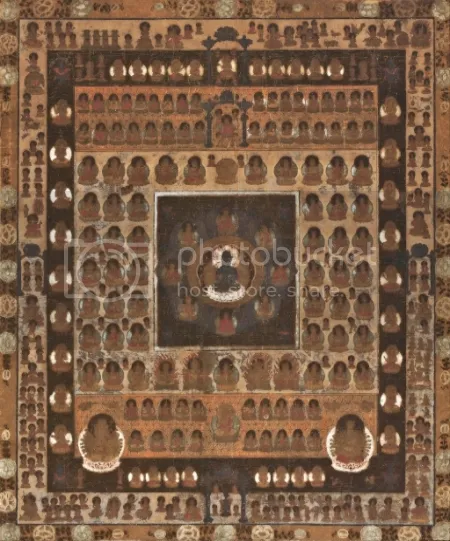
From commons.wikimedia.org
Because of its profound symbolism and the elegance of its form, the lotus flower also features predominantly as a motif in Buddhist temple architecture. The lotus bud finial is a common feature on railings and poles, while stylized lotus flowers are often arranged artistically to decorate the beams of corridor roofs. Many ritual vessels and containers crafted from bronze, clay, and lacquer are created in the shape of lotuses or feature lotuses scrolling across their surfaces, and in such Buddhist textiles as the robes of priests and the silk brocade backing for paintings of deities, the lotus is the most common of all decorative motifs, suggesting the purity and spiritual power of the wearer or the deity depicted in the painting.

Kyongju, Korea. Photo by the author
The prevalence of the lotus in Buddhist art, iconography, and architecture not only provides inspiration to followers of the Dharma so that they, too, can rise from the mud of ignorance and become perfected beings—the ever-present motif in Buddhist paintings, statuary, textiles, architecture, and ritual objects is a daily, even hourly, reminder of the Buddha’s teaching about this flower and what it represents in every moment of practice: “Like a lotus flower that grows out of the mud and blossoms above the muddy water surface, we can rise above our defilements and [the] sufferings of life.” (Buddhanet.net)







